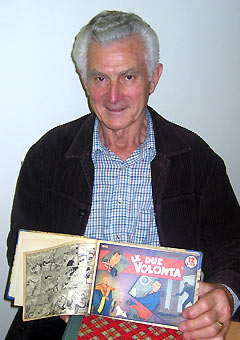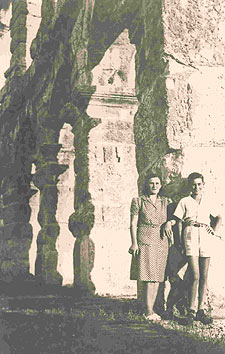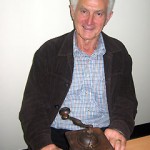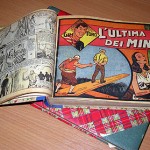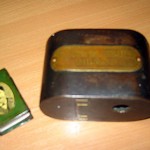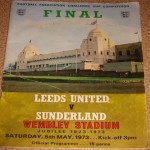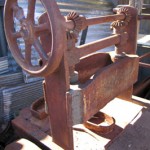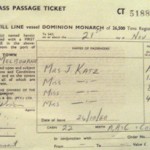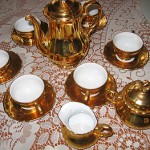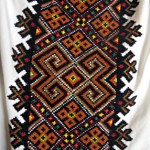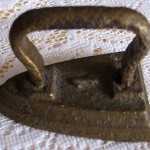Italian
Pola, Istria, Italy (now Croatia )
Naples, Italy on 19 July 1951
Melbourne on August 1951
Bonegilla in August 1951 for two weeks
Chullora, Sydney; then Coolah
Apprentice labourer at Chullora railway workshop in south-west Sydney
Handyman at garage and hospital in Coolah, north-west NSW
I was born in 1935. My mother Caterina and I were originally from Pola in Istria, then in Italian territory. When it was given over to Yugoslavia and became a communist country we didn’t want to stay there anymore. We opted to go to Taranto, south of Italy and we stayed there for two years as refugees.
After the war there were no prospects for good jobs for me in Italy, so my mother, who was single and had an aunt in Argentina, thought we would go there. When we went to Cinecitta (a film studio turned into a refugee camp in Rome) to have our medical examinations, we found out there was an International Refugee Organisation that paid the fare for migrants. We were accepted because we were refugees coming from Pola. From Taranto we went to another camp in Bari (Italy) to wait for a ship. After two years in camps, my mother had used up all the money, so we were forced to go anywhere we could. Migration to Argentina had closed so we had to choose between Canada and Australia. Canada we thought would be too cold so we chose Australia.
As we had been refugees for two years and moved around a lot, so didn’t have a lot of luggage, just one suitcase and a baule (trunk) with our basic things like clothes and some saucepans. My mother also packed her special coffee grinder that she couldn’t live without. Just as well, when she tasted Australian Nescafe she said it tasted like acqua sporca (dirty water), very different to Italian coffee.
I packed my giornaletti per i giovini (comic books) that I had made between 1948 and 1949 in Taranto, Italy when we were in the refugee camps. My mother gave me money to buy fruit and I would buy comic books instead. In Averso (another refugee camp in Italy) I did a course in bookbinding and I used my skills to bind together my comic books. At one time I had about twenty of them (bound books). I had hoped that my grandkids would like them, but they don’t even speak Italian.
We also brought with us the musina (money box) we used to save our coins in and there was a slot where we folded the notes. My mother gave it to me to try to teach me the importance of saving money. It’s very solid as you can see, but unfortunately I have lost the key to the lock. These few things, we thought would be useful in Australia and serve as a reminder of our life back in Italy.
In 1951 when I was 16, my mother and I boarded the Castel Bianco in Naples and in one month, in August that same year, we arrived in Melbourne . The trip for me was an adventure. The Castel Bianco was a small boat and for a few days we experienced very rough seas. I remember on the dining table they that put divisions so your plates would not fall down. We met some people on board but didn’t continue the friendships because they all went off in different directions.
In Melbourne, we got on a train to Bonegilla. It was a bit better than the other Italian camps we had stayed in. In Italy, the huts had large rooms divided by military blankets, but in Bonegilla we had a small hut divided by timber frames with metal paneling. My mother and I had a small room to ourselves and that was good. No cooking, we all ate together in the canteen but the food was not a hundred percent.
My young friends and I used to catch rabbits in camp. I remember trying to catch them up against the wire fence. We didn’t have guns or anything and once I jumped on a rabbit and I caught my pants on the fence and tore them while the rabbit ran away.
I was one of the first ones to go out to work from the group that came on our ship. I think it was only 10 days after we arrived that I left Bonegilla for my first job at the Chullora railway workshop in south-west Sydney. I was given accommodation there onsite with some other men but I had no idea were it was. I had to leave my mother because we had signed an agreement to work and we didn’t want to complain.
After one week, I got a pass to go back to Bonegilla to see my mother but she had also been sent away. No one knew she had gone. I wasn’t too happy but I knew that I would hear from her soon so I went back to Sydney to work. A week later I got a letter from her to say she was in Coolah, that is in north west of NSW. She was sent to Coolah District Hospital as a maid. I had to wait about a month for a pass to go to see her.
I had all sorts of trouble trying to get to Coolah to see my mother. What with my broken English, getting on or off the wrong trains or getting on a goods train that took so long to arrive. It was ages before I managed to see her. In the meantime we were writing to each other and my mother must have thought that I was starving because she sent me a big cake through the mail.
My mother wasn’t too happy with the situation. Even though we had signed a two year work contract, she told the matron at the hospital that if she couldn’t be with her son she wouldn’t stay there. So the matron started looking for a job for me in Coolah. She found me a job at a local garage as a general handyman. They had a school bus service so I was to clean the bus and help out around the place.
My mother had a room in the hospital grounds and at first I boarded in a private house. I had a bed on the verandah but it was so cold in winter that I had to go to bed fully dressed. The good thing was I could see my mother in the evening. After about two months the job at the garage finished so I took a train back to Sydney to look for a new job. I remember walking up and down Parramatta road but with no luck.
Around Christmas time, the handyman at the hospital left and I was offered his job. That meant that I had a job next to my mother and we could share the same room. That made us happy because we could now start to save some money. We were there until 1957, a good six years. During that time I improved my English by taking lessons with the nuns after work. The also taught me to play the piano and I can thank them for my love of music today.
Things were good for me in Coolah, I had lots of things to keep me busy, tennis and movies, but I could see that my mother was not happy there even though we had met and made friends with another Italian couple. In 1957, these friends moved to Sydney, I said that we should do the same thing.
In Sydney, we stayed in Concord with our Italian friends to whom we had lent some money to buy a house. We shared a room in their house for a year until we bought our own house in Concord in 1958. We have lived in Concord ever since.
I met my wife Rita in 1961 at a local church, St. Mary’s, Concord at the Mater Dei Club and we got married a year later. When I think about those early years in Australia, it was a real adventure for me but for my mother, who remained single, it was a very lonely time.
Interview conducted:
17 May 2005


